Paul Sellers! Where Are You?
It’s not confusing to me, but it could be for some. Go through my history and you’ll see my life journey begin in Stockport, England, near Manchester. It was from there that I migrated to a new life in the USA and built my Texas home, continuing my lifestyle as a woodworking furniture maker designer. Two decades passes quickly and the National Trust UK in North Wales provides me with a wonderful workshop in a castle, Penrhyn Castle, to start my New Legacy School of Woodworking. In spots in between I travel twelve US states in quick succession four times in four years to teach woodworking masterclasses for The Woodworking Shows and then we start to make videos in places ranging from the castle to my back garden and now you see me in what looks like a come-down in a garage. Whoah! What happened?
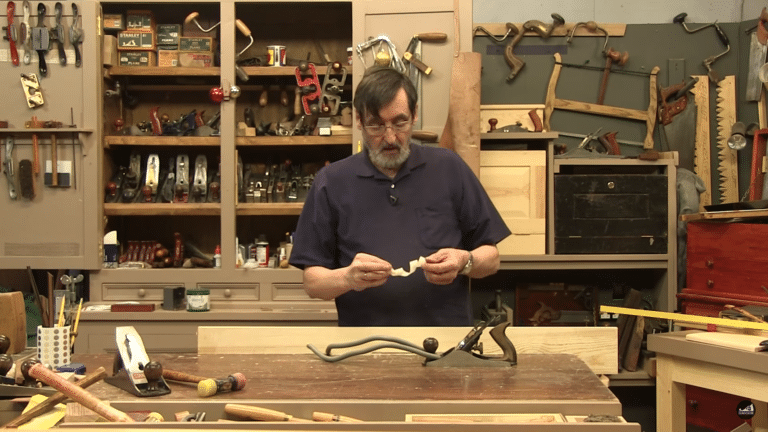
For me it’s all part of a very cohesive whole. Oh, there are a few seams here and there, but it’s more an unfolding plan than a haphazard series of events. In 2010 I began considering the possibility that there was an emerging generation that would or could never visit me either in the US or the UK. Many hundreds of thousands of them. My touring and my teaching showed me that these woodworkers were the backbone of future woodworking and that they were the ones really searching the internet looking for good content on hand tool woodworking. I had proved what I was teaching was good on a person to person level in direct contact via classes and shows. The question was would people believe that they could learn woodworking with me online via social media and online classes with woodworkingmasterclasses.com. Well, it was me that wasn’t sure and not the audience.
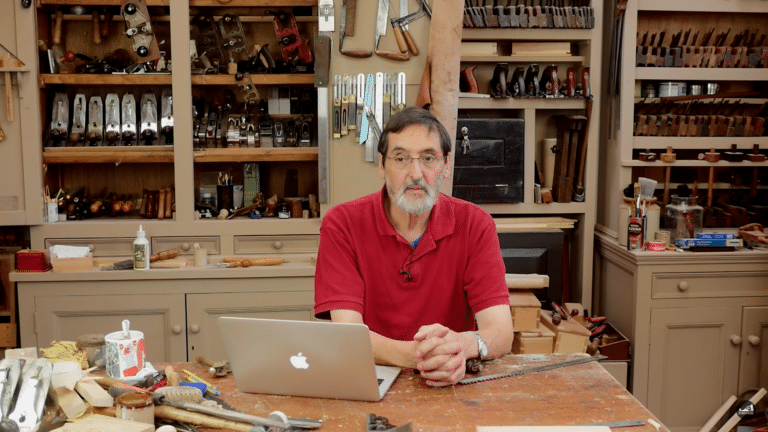
Our first serious filming was on an Apple iPhone at woodworking show in the North of England cutting a dovetail. Soon we were filming in the castle with two camcorders. Today In heard people are little confused as to exactly ‘just where is Paul Sellers?” I see now where the confusion has occurred. If you see one of many a dozen videos from pre 2015 you’ll likely see me in a castle with dark grey walls and slitty windows as above. Join me in early 2016 you will see my in a new and somewhat white-walled workshop a little way outside of Oxford in Long Wittenham, only a few miles along the Thames River…
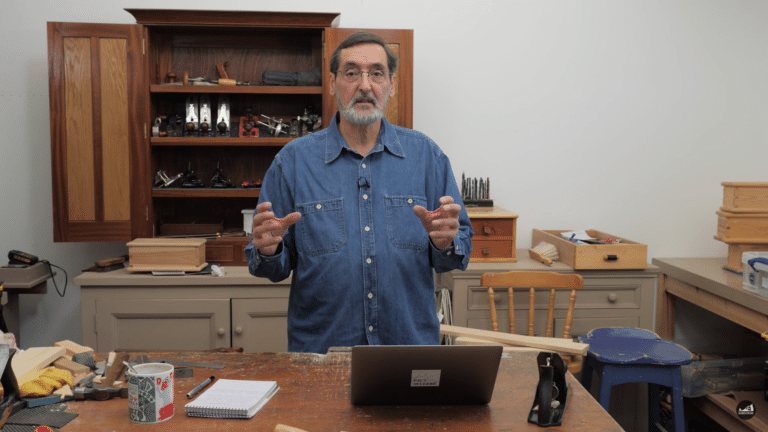
…but then you’ll see me building and filming my workbench series in a new garage space. What? What’s going on Paul?
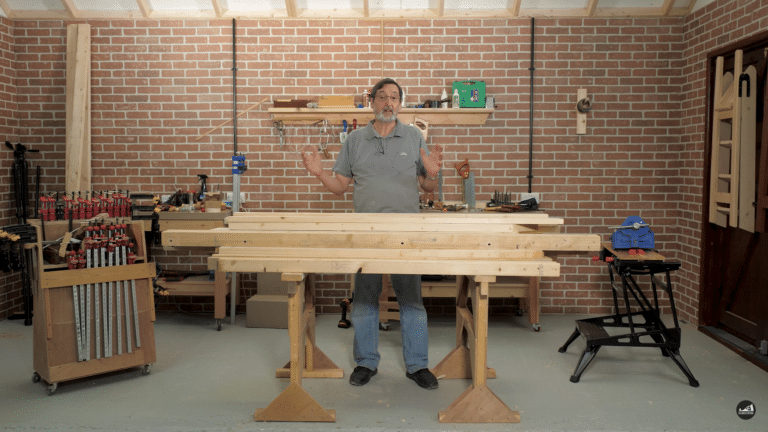
So what really happened here? Well, we did the research. That led to an experiment where we built a dummy garage film set to trial our idea that, because our findings showed that the largest percentage of you, our audience and friends, worked mainly in a single-car garage sized space or less, and we knew that my woodworking was always done in a similar sized space, we could reconstruct a real garage sized space as a permanent space for me to create my future work and video content in. So, now I make fine woodworking happen without much specialised equipment and an incredible workshop facility that I just love. What I discovered was that my garage space was extremely efficient. It’s a fantastic space, big enough to make anything I want to in.
Why would I want anything else? Anything bigger? Anything more ordinary? Beautiful things are often made with ordinary hands, ordinary tools by ordinary people. That is the historical background of most if the world’s finest furniture and woodworking treen. Why change it?


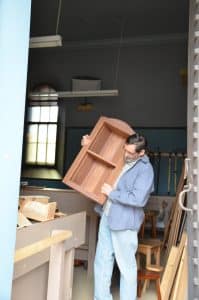
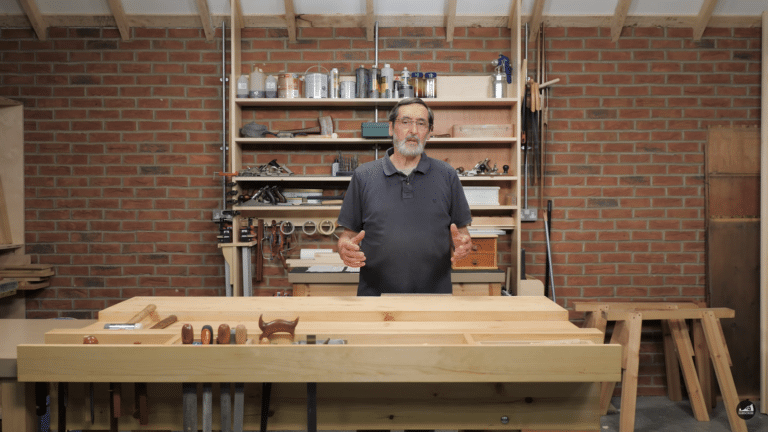
Than you Paul for your commitment to the new venture, it has made me feel I have not been wasting my time working with hand tools in my garage/workshop. For years I have watched Norm & Co fire up there machinery and make good cabinetry work look so easy. Then I would go to the garage thinking am I being left behind. I even started buying those throw away handsaws.
One day while surfing the net or the web I came across your good self, it was like a breath of fresh air, how silly I’ve been forgetting things that were taught to us as apprentices, all for so called progress.
Looking forward to seeing more on your site.
Thank you.
David.
Have been working out of a very small basement shop for some time now….getting ready to build a 3 drawer Chest of Drawers for a Grandson at the moment. You would have more space to park a VW Beetle in, than what I have to work with…..glue-ups can be a challenge, somedays.
This year I began inventorying all my tools acquired over the years and realized I have some awesome saws, planes, and chisels. I love woodworking and I don’t have space in my garage for table saws, band saws, and other large power tools. Hand tools seem to he the natural direction to go. I look forward to downsizing my inventory and working exclusively with hand tools. Thanks Paul.
Paul I was given an extremely old scratch tool made by Preston with 2 adjustable fences yesterday by an 88 year old furniture restorer……an amazing man. He can no longer stand but we have many chats on his experiences as a restorer. I feast on his words. He also gave me his own made scratch tool, simply consisting of a 11/4″ wide section of hacksaw 11/2″ long, shaped as a reeding cutter clamped between two rough pieces of scrap wood.
I set the cutter into the purpose made Preston scratch tool and then cut along the edge of 1″ mahogany offcut, burnished with shavings to give a lovely finish. I can make my own cutters with a dremel tool. I could then cut off the edge to give a thin decorative bead.
These tools cost pennies as does a sticking board……many many of your followers have asked for tuition on decorative enhancements.
Whilst I with many would agree you can’t be all things to all people I really can’t understand why you refuse tuition on such a simple tool as a scratch together with a length of timber called a sticking board.
I would be really pleased to see a reply Paul
Regards John 2v
Mr. Sellers, you have spoken of the “Red Pine” as a well liked material in the UK. Would it possibly be comparable to Douglas Fir in North America. I would imagine you would have used it during your time in the US, it is fairly popular. It is both harder and more weather resistant than White Pine.
Not comparable at all I’m afraid. Redwood (Pinus sylvestris) is also known as Scots pine (UK), Baltic redwood, Finnish redwood, Archangel redwood, Russian redwood, Polish redwood, red deal, yellow deal.
Hi Paul I see you have managed to find time to reply, ( do not mean to sound disrespectful) I wish you would answer my comments re scratch tools and sticking board.
Regards John
Reply to pine question forgot to say
Very well. Personally I do not like moulds, and the over use of them. I do not like classicism as it stultifies the art of work development. I leave this to the followers of router magic. Why replicate without thought when you can shape from your own thought and mind and your free will to do so. I like simplicity mostly. I do like moulding planes, the art of them and the art of the men that made them. I see that they are of little interest to the majority, mostly because they are so complex and you need so many to do what the power router does extremely well. A scratch stock pattern (shape) is simply a matter of shaping the required shape onto a pate of steel and, if you want to, hardening the pate and e=annealing it to give the ability for subsequent sharpenings. Cutting out a 90 degree corner in to any scrap of wood and then a saw kerf along the length into that corner gives you the stop you need to determine the final levels. I have not used sticking boards since I was a journeyman because it is so easy to apply the moulding in thicker, wider stock and then cut off whats needed.
Thank you Paul…….there you are…..”apply the moulding in thicker wider stock and then cut off what’s needed”
You know that from experience but I didn’t…..infact learnt it from my 88 year old furniture restorer two days ago, when I showed him his restored 1900 circa scratch tool.
In short it’s so easy when you know how again as far as sticking board the vast amount of your readers would not have a clue but amazed if you were to show them Paul.
Tutt tutt power router I have a good one under the bench, would gladly give it away
Regards John & thanks for reply
Hi Paul (not Peter) —
It took me almost two years to get my (Paul Sellers-instructed) workbench built, but I’m so happy with it. Nothing to it once, I sent you a photo of my benchtop as I struggled for weeks trying to get a shaving rather than sawdust out of my plane. I wrote sending you photographic evidence of my troubles, coming to believe America either had “bad wood” or I was failing in the sharpening department as I tuned my new Stanley No. 4. Your team sent me to your video on setting up a plane, which I had watched many times already. But following instructions I watched it twice more. Then it struck me, as the first words out of your mouth were — almost all bench planes are ‘bevel down.’ I raced to my plane and what did I discover? When I tuned-up my new (and first) plane, I had installed it sharp, but upside down, bevel up. (Tried to post photos of completed bench here but can’t seem to do it.)
I hope my first dovetail box comes more easily. Lol.
Thank you,
Jim Gierach
Chicago area
Can’t leave this one alone Paul ….using routers???? What are you saying? I would agree not all people have moulders and they can be fiddly but when set up cut a crisp clean mould, that’s where you come in. To advocate using a router is against all you have taught us.
Some 30 years ago I had a work order to repair window sashes. They were Victorian bay windows, all had decorative exterior mullions and transoms cut from 6″x 4″ pitch pine face moulding would have been formed with hollow and rounds.
To machine these would require a multi wing 3″ radius cutter ….hollow and round.
I just can’t remember how on earth I made new ones, never even heard of hollow and rounds then but they are still to be seen today.
Electric routers are noisy, dusty and dangerous, I can use my moulders any time day or night without disturbing others. Plus I have collected 65…a shear joy to use on my 8′ sticking board.
Regards john
I’m sorry John but not everyone wants or needs dedicated moulding planes for their work. I avoid mouldings for a variety of reasons but mostly because they make my work look like routed work. I have never been opposed to the use of any machine even if people took it that way. The reason most people were constantly turning to machines is that they never developed or believed they could own skill. That’s changed, mostly because of what we do. It does no mean machines should never be used. And I’m not carrying this on from here. I gave you an honest answer because you made the demand.
Paul,
I don’t care where you film, it could out in your back yard for all I care (yes, I loved that workbench series you did outside years back) as long as you are keeping us going I will always be a fan and one of your advocates here in the states. Keep up the good work and here is to many more years of Paul Sellers’ unvarnished truth so to speak!
Paul,
I just downloaded the Hi-Res Spokeshave and Framesaw project videos, they are stunningly well done in both the style and pace of project development and the crystal clear video detail.